Clematis Snow Queen - Growing Tips
The valuable and rare Clematis Snow Queen was bred by Dutch breeders. This plant has a high decorative effect and long, lush flowering. Consider its characteristics, the rules of planting, care and reproduction.

Clematis the snow queen photo
Description of the variety
The botanical name of the variety is Snow Queen. Translated as "The Snow Queen".
The hybrid large-flowered plant has high frost resistance, therefore it is suitable for cultivation in all regions of our country.
A beautiful luxurious bush with large white flowers with a diameter of 18-19 cm. The petals are elongated, pointed at the tips, corrugated along the edges, covered with a lilac haze. Light green stamens.
Stems are long, sinuous, reaching 2-3 m. Leaves are bright green, oval or round, sharp at the end. The leaf plate is thin, smooth.
Long-lasting flowering - begins in the last decade of May and ends at the end of August.
Landing features
The best time to plant seedlings is spring. It is necessary to wait until the last frosts pass and the above-zero temperature stabilizes. It is important that the soil warms up to 10-12 ° C, then the risk of freezing of the roots after transplanting into open ground is excluded.

Clematis Snow Queen
Seat selection
The main requirements for the site are a little shading at lunchtime, no drafts. The plant has a superficial root system, so the depth of the groundwater does not matter. It is important that there is no stagnation of moisture.
The soil is suitable for light, porous with a high content of minerals and organic matter. Better to plant on loams with the addition of sand or vermiculite at the rate of 20 kg / m². If you are going to grow liana on sandy loam soil, it is worth adding a couple of buckets of clay.
Acidity is no less important, since clematis grows poorly on acidified soil and blooms poorly. The optimal indicator is 6-7 units. If it is higher, the place for planting is sprinkled with dolomite flour, slaked lime or chalk - 400 g / m².
You should not plant shrubs near the walls of a house or outbuilding, since water flowing from the roofs during the rainy season can provoke crown rot and the death of the plant.
Seedling preparation
The best planting material is a purchased seedling. You can purchase it from one of the gardening nurseries. So you will surely get a plant with all the varietal characteristics.

Snow queen clematis
When choosing, give preference to a grown specimen, in which the crown consists of several densely leafy stems. Such bushes have a strong and well-developed root system.
As a rule, clematis are sold in containers or together with an earthen ball. It protects the roots from drying out.
Examine the crown carefully - the shoots should be flexible, without signs of mechanical injury and disease. The leaves are juicy, fresh, of a single color.
Before planting, the roots are cut to 2-3 cm in length, dipped in water for 3 hours to speed up rooting.
Landing technology
The pits are harvested two weeks before the planned planting. Their depth and width depends on the size of the roots, the approximate parameters are 60x70 cm. A little drainage is poured into the bottom, which will ensure a quick outflow of excess moisture. Use pebbles, brick chips or screenings.
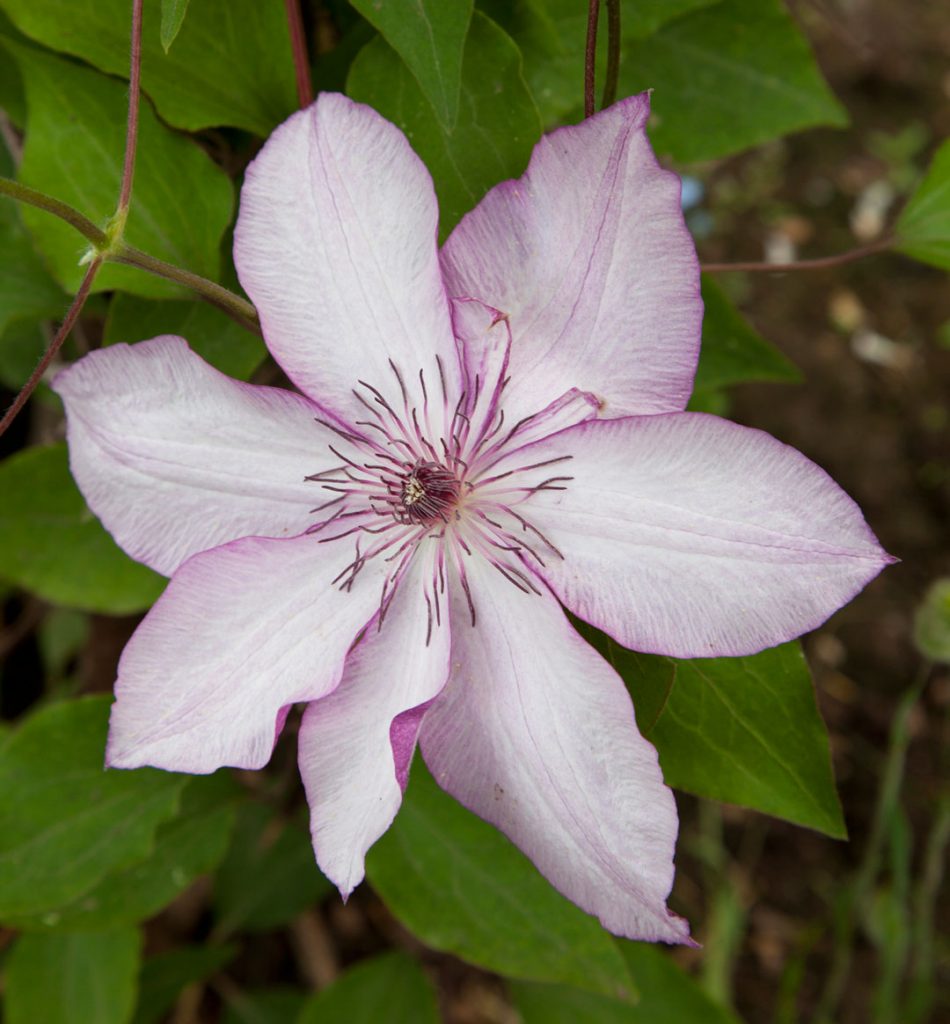
Clematis snow queen
A bucket of dug earth is mixed with 5 kg of humus, 100 g of slaked lime, 200 g of wood ash and 150 g of superphosphate are added to this mixture. To prevent the roots from getting burned, the fertile soil mixture is sprinkled with a thin layer of garden soil.
The roots are lowered, straightened in different directions, sprinkled with soil to the top so that the root collar is flush with the soil surface. Crush at the bottom of the stems, moisten. Consumption per bush - 7-8 liters of water.
In order to avoid drying out of the earth and roots, the near-trunk zone is sprinkled with mulch from peat or last year's manure.
In group cultivation, it is necessary to adhere to the distance between the seedlings - at least 30 cm. So the bushes will have enough space, moisture and nutrients for full growth and flowering.
Care requirements
Watering
Clematis does not tolerate drought well, so the soil should be slightly moistened. Water the flower as needed - after the soil dries out to a depth of 5-6 cm. Consumption per plant - 10 liters. For humidification, it is better to use warm and settled water.
In a rainy summer, watering is excluded, otherwise the root system quickly decays.
After watering, the soil is loosened superficially, which helps to maintain its moisture and breathability. Periodically weed the bed between the rows, remove weeds in time.
They also add mulch from peat or humus - these components prevent the growth of weeds and retain moisture in the soil.
Top dressing
Feeding begins 2 years after planting. In early spring, nitrogen-containing preparations are worn, which accelerate the process of growing roots and green mass.
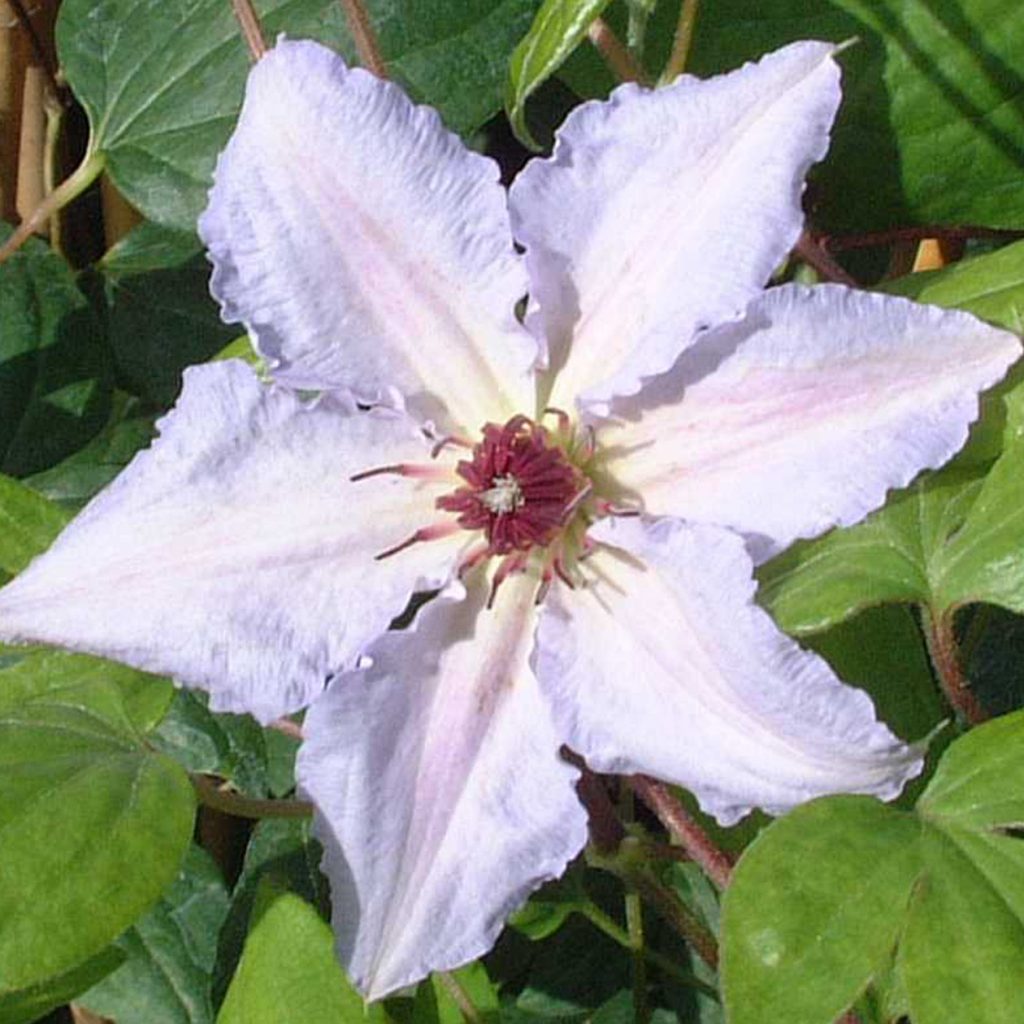
Clematis the snow queen
Before budding, they are fed with a mixture of superphosphate and potassium nitrate. These trace elements improve the quality and duration of flowering, increase immunity against diseases.
The third time is fertilized in the fall, when the plant has faded - potash fertilizer is poured into the holes, at a distance of 50 cm from the near-stem zone.
In order for the roots to absorb nutrients faster, each top dressing is combined with abundant watering.
Usually, ready-made complexes for decorative flowering shrubs are used to feed clematis. Dosage according to the instructions on the package.
Pruning
Clematis does not need shaping, only those stems that thicken the crown, give it an ugly shape, need to be cut.
Every spring, they carry out a sanitary haircut - they remove frozen, rotten or dried branches. Cut with a sterile and sharp secateurs. After the procedure, the cut sites are irrigated with copper sulfate to prevent infection.
Preparing for winter
Young clematis, which are weakly resistant to winter cold, need insulation. The trunk circle is sprinkled with a thick layer of peat. All non-viable parts are cut out. The remaining shoots are tied into a bunch, bent to the ground. Cover from above with fallen leaves, compost or spruce branches.
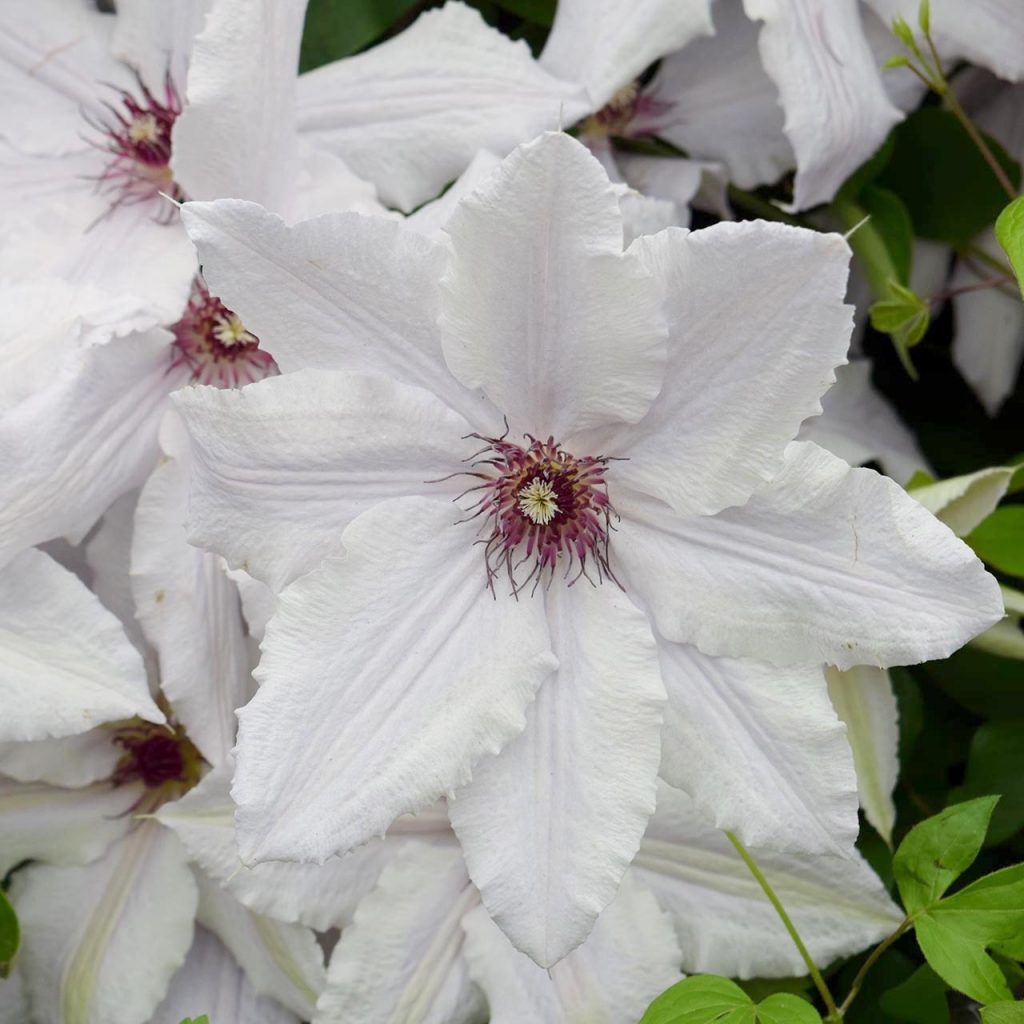
Clematis Snow Queen description
The covering material is removed in the spring, when the threat of recurrent frosts has passed.
There is no need to insulate an adult liana. The only thing that needs to be done is to mulch the near-trunk circle with peat or humus.
Reproduction methods
Clematis the Snow Queen reproduces in several ways, if all the rules are followed, the success of breeding new specimens is guaranteed.
Stem layering
On an adult bush, the most flexible and strong shoot is chosen, close to the ground. Remove all the foliage on it.A groove 5-6 cm deep is pulled out nearby. The bottom is sprinkled with a nutrient mixture of peat, humus and sand (1: 1: 1). A twig is lowered into it in a horizontal position, pinned, covered with the remaining fertile composition, watered.
A week before the first frost, fallen leaves, compost or rotted manure are poured up. Such insulation will provide additional nutrition and protect the stem from freezing.
In the spring, when the heat outside has stabilized and the last frosts have passed, the shelter is removed. The branch is dug up, cut off from the mother bush. Divided into several segments with roots, seated separately in the garden.
Cuttings
They are harvested in spring or summer. Take the apical parts of the current year 12-15 cm long. At the bottom, they cut off the leaves, dipped for an hour in a solution of Kornevin or Heteroauxin.
After soaking, the shoots are planted in a moist and loose mixture of peat and sand to a depth of 3-4 cm. Moisten, cover with transparent material, put on a warm windowsill with diffused daylight.
Every day, the seedlings are ventilated, watered if necessary. After about 2-3 weeks, new leaves will appear on them - a sure sign of successful rooting. Then the shelter is removed, they grow for another month. Then they are planted in open ground.
By dividing the bush
This method is suitable for old shrubs that have stopped growing and bloom poorly.
The technology consists of several stages:
- the liana is watered abundantly;
- an hour later they dig in, remove from the soil;
- wash off the remnants of the soil, dry;
- using a garden shovel, the shrub is divided into parts - for successful rooting, each delenka must have several roots, one stem with buds and leaves;
- the places of the cuts are treated with a solution of copper sulfate, dried, planted in the garden.
Diseases and pests
If the growing rules are violated, various infections and parasites may appear:
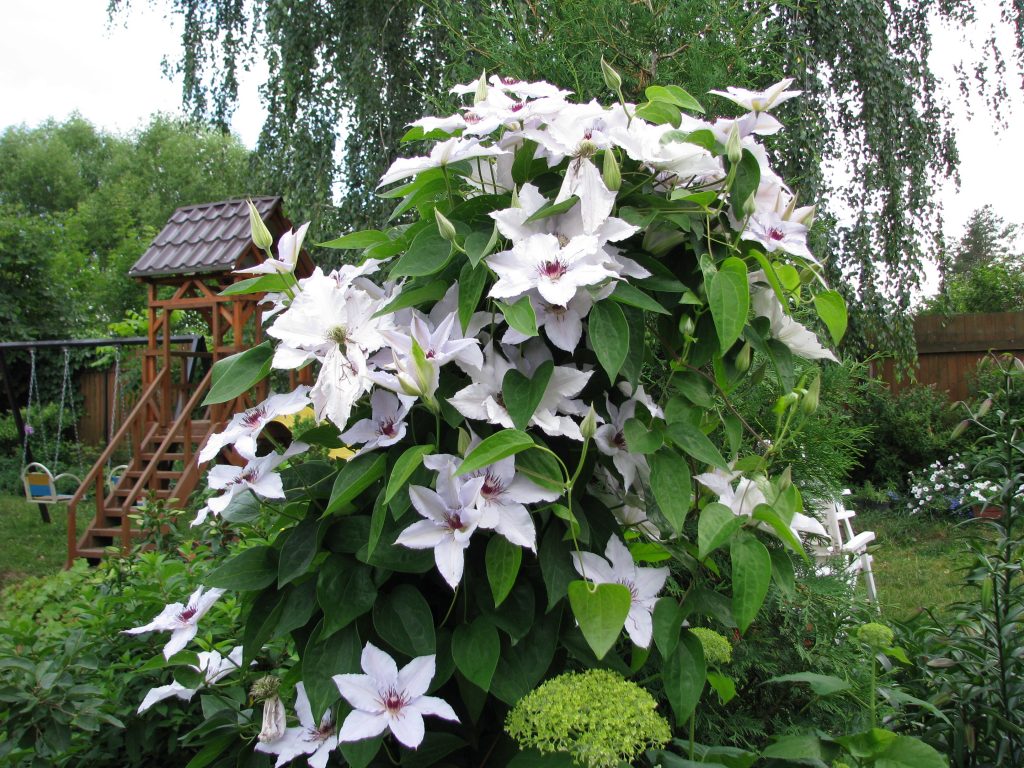
Clematis Snow Queen reviews
- Rust. Signs - red growths on the leaves and stems. Over time, these places turn brown, curl, dry and fall off. It is necessary to remove the infected parts, then treat the crown with fungicides - Bordeaux liquid or copper sulfate.
- Gray rot. Brown spots with a grayish bloom appear on the foliage. The plant stops growing, stops blooming. Fungal spores are quickly carried by the wind to healthy flowers. Therefore, at the very first symptoms, urgent measures must be taken - to remove all infected organs, sprinkle with a fungicide (Gamair, Fundazol or 2% Azocene solution).
- Powdery mildew. A whitish bloom on foliage, which darkens over time and contributes to its yellowing, drying and falling off, is a sure sign of infection with this fungal infection. In the fight, Ridomil gold, Skor or Hom are used.
- Wilt (wilting). The fungus concentrates in places where the bush is injured, clogs blood vessels, and prevents the access of moisture, oxygen and nutrients. It is impossible to cure this disease, so the vine is dug up and burned. The hole is spilled with a strong solution of potassium permanganate or copper sulfate.
- Of the pests, root-knot nematode often damages. Penetrates through the root system, which leads to its death. The whole crown withers and dries up. For treatment, nematicides are used - Carbation or Nemagon.
In order to avoid infection, it is necessary to provide the shrub with competent and timely care. Buy healthy and strong seedlings, keep the flower garden clean - remove weeds in time, weed the aisles, cut off non-viable parts, avoid planting overgrowth.
Application in the garden
Thanks to its lush and colorful bloom, this plant has gained great popularity in landscape design:
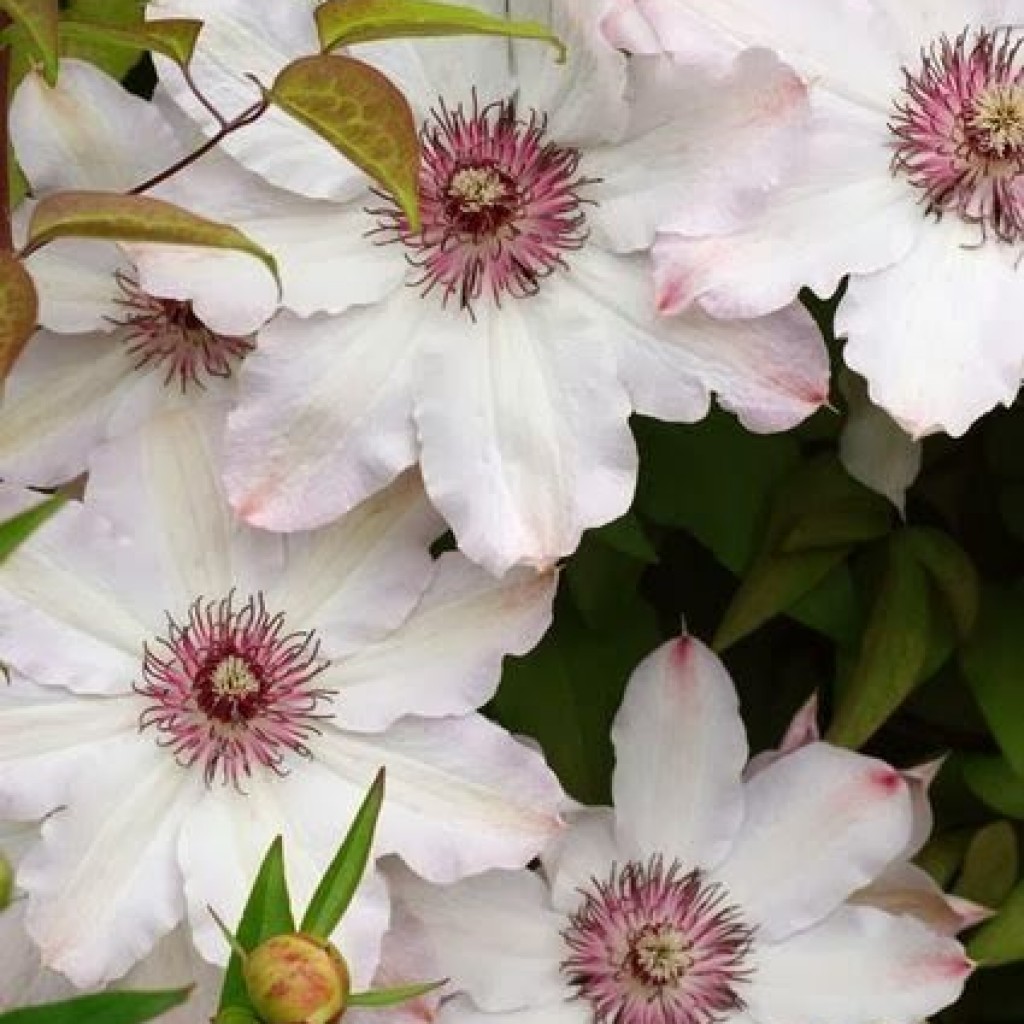
Clematis hybrid snow queen
- it is planted singly near arches, gazebos, terraces;
- combine with other varieties of clematis, planting along fences to create a variegated and vibrant hedge;
- The perennial liana looks beautiful surrounded by decorative deciduous and flowering perennials - hosts, junipers, roses, rhododendrons.
Testimonials
For many gardeners, this variety is of great value in gardening:
- a frost-resistant plant grows and blooms fully on all types of soils, which allows its cultivation in any area;
- is not afraid of gas pollution, therefore it decorates not only the house adjacent, but also the roadside area;
- successful reproduction in various ways makes it possible to obtain a large number of new bushes to create original compositions in the garden.

